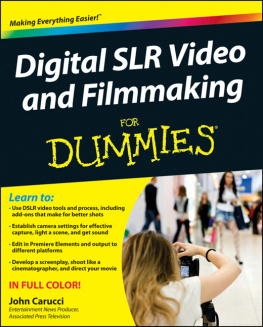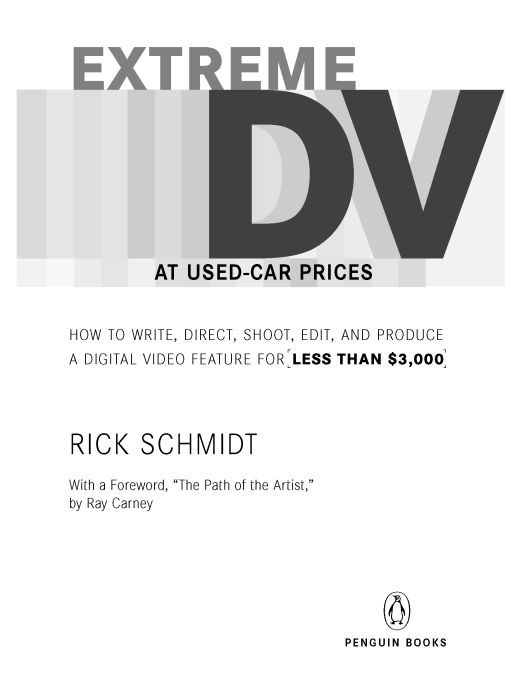Table of Contents
Praise for Feature Filmmaking at Used-Car Prices
By Rick Schmidt, one of the worlds top independent film gurus (MovieMaker)
Rick Schmidt, whose Feature Filmmaking at Used-Car Prices is the undisputed champ of low-budget bibles, was the guru of choice for many of todays top indie moviemakers long before this new trend [of DV moviemaking] began.Glen Berry, MovieMaker
Intelligent, personable, and carnivalesque... An intriguing book that takes on Hollywood with a healthy, do-it-yourself attitude.... I can think of a lot of studio heads who should read this one and meditate!
Cineaste
Its as much an inspirational book as a step-by-step guide to the process of making no-budget movies.
John Hartl, film critic, The Seattle Times
I wish I could have read this book thirty-five years ago, before I made my first low-budget features.
Vilmos Zsigmond, cinematographer, Deliverance, The Deer Hunter, Close Encounters of the Third Kind, The Crossing Guard
Rick Schmidt is the only person on Earth who could shoot an entire feature film inside a used car... and then sell the film (and car) for a profit.Nicholas Kazan, screenwriter, At Close Range,
Reversal of Fortune, Patty Hearst, Dream Lover (also directed), Fallen
An indies A to Z... If you want to jump on in, Rickll get you rolling.
Jon Jost, feature filmmaker, Speaking Directly, Last Chants for a Slow Dance, Frame Up, Sure Fire, All the Vermeers in New York
PENGUIN BOOKS
EXTREME DV AT USED-CAR PRICES
Since the early 1970s, Rick Schmidt has written, directed, shot, edited, and produced more than twenty indie features, which have been presented at over fifty film festivals, including the Sundance Film Festivals Dramatic Competition, New Directors/New Films, San Francisco International, Berlin International (Panorama), London Film Festival, and Channel Four (England) (see www.lightvideo.com/films.aspx). His first no-budget feature, A Man, a Woman, and a Killer, directed with then roommate Wayne Wang (Joy Luck Club, Smoke, Maid in Manhattan ), won Directors Choice at the Ann Arbor Film Festival. When his fourth feature, Morgans Cake, premiered at New Directors/New Films in New York, Janet Maslin of The New York Times called it [A] deadpan, unpretentious delight... one of the most promising of the festival. His fifth feature, American Orpheus (Seattle International, Rotterdam International), was awarded the Gold as The Best Low-Budget Feature of the Year at the Houston International Film Festival.
Recently Schmidt has had the distinction of cowriting, codirecting, coproducing, and executive-producing Chetzemokas Curse (Dogme No. 10) on DV, only the second American feature to receive this official certification from Denmark. Curse was coproduced with his son, cinematographer Morgan Schmidt-Feng, in a seven-way writing and directing collaboration at Schmidts ongoing Feature Workshops.
Besides producing cutting-edge, award-winning movies, Schmidt has influenced a generation of moviemakers with his classic how-to, Feature Filmmaking at Used-Car Prices (Penguin Books), which MovieMaker magazine calls [T]he undisputed champ of low budget bibles. Schmidt was the guru of choice for many of todays top indie moviemakers long before this new trend began. His list of distinguished readers includes filmmakers Kevin Smith (Clerks, Chasing Amy, Dogma, Jay and Silent Bob Strike Back) and Eduardo Sanchez (The Blair Witch Project), as well as action star Vin Diesel (The Fast and the Furious, Pitch Black, XXX ), whose mother bought him Ricks book to help encourage a filmmaking career.
Schmidt has proven himself an able spokesman for the new DV revolution. Interviewed at www.wired.com (February 2002) he had this to say: Digital video gives the little guy the illusion of big budgets, and that helps people make Dogme movies. The timing is so well aligned with the digital-video explosion. There may be 25 official Dogme films, but there are probably 20,000 working on their movies. A 12-year-old kid can be making a movie. The timing is extraordinary to make a new wave of art-house hits.
For Julie
Always stay in your own movie.
Ken Kesey
A PREAMBLE
Hello, new moviemaker, and welcome to the world of extreme digital video (DV). This book will show how you and your friends can make a DV movie even if you lack funds or past experience. The low $3,000 price tag for writing, directing, shooting, editing, and producing a DV feature, as sited on the cover, refers to the purchase of an affordable Mini-DV camera, a computer and monitor, and nonlinear editing (NLE) software (a DV moviemaking workstation). But if you have access to DV equipment through school or friends, the production costs can drop to almost nothing. As opposed to producing a feature-length movie in film, where just the film stock and lab processing costs can easily exceed $10,000, DV moviemaking may be accomplished with just a few inexpensive DV cassettes. Anyone can go out and purchase an hour-long Mini-DV cassette for less than $10!
In fact, this book could have been titled How to Make a DV Feature for $10 if more videographers reused their tape, as Arkansas-based moviemaker Beau Anderson does. While I was visiting the Ozarks Foothills Film Festival in Batesville, Arkansas, I got to chat with Beau in front of the historic Melba Theater there and learned how hed rerecorded over a certain Mini-DV tape thirty times and that only around the thirtieth time had there been some fuzzy dropout on one section of the tape. That means that only after hed shot 29 hours of DV was there a breakdown in the overall quality of the Mini-DV tape. For several of my films, including A Man, a Woman, and a Killer, 1988The Remake, and American Orpheus, shooting 8-10 hours per production provided enough footage to cut those feature-length works. Beaus $10 recycling process would supply that total amount of raw material.
For his movie, Beau would capture (called log and capture in the terminology of most nonlinear editing software systems) each hour of Mini-DV images into his computer before reshooting on the tape again, sort of like using the Mini-DV cassette as a water bucket that he could refill and empty again and again. Of course, there was the risk of not being able to retrieve the images from a computers hard drive if something bad were to happen (the dreaded computer crash!). But if he had a stable editing software program and a dependable brand-name external hard drive for storage (and backup) of image and sound files, he could then edit each hour-long cassette down to the crucial shots, achieving a fine-cut, then export the short sequence back to another master DV tape, filling up that cassette with the accumulating movie before clogging the computers memory with the next hours worth of raw footage. Off-loading rough cuts in full resolution to DVD-R disks, using the Mac G4/G5 Super Drive DVD burner, is another option. But regardless of the editing process Beau used, his frugal money-saving attitude for shooting is to be commended. Perhaps this method of rerecording will help some fledging moviemakers with literally no budget get started making their DV features, by making use of whats available at home and at schoolperhaps a parent-owned consumer DV camera and an iMac with built-in iMovie editing software. The point is that, in this day and age, there are plenty of opportunities to acquire the equipment you need to make movies if youre determined enough.











